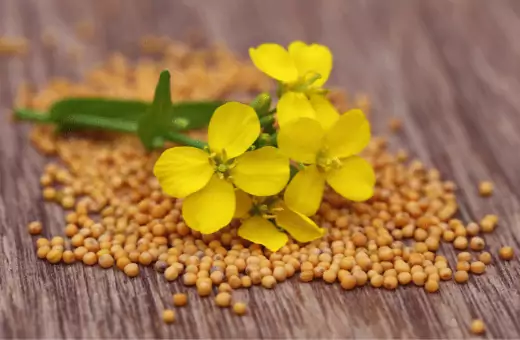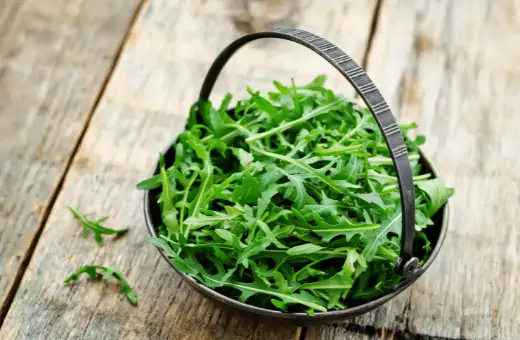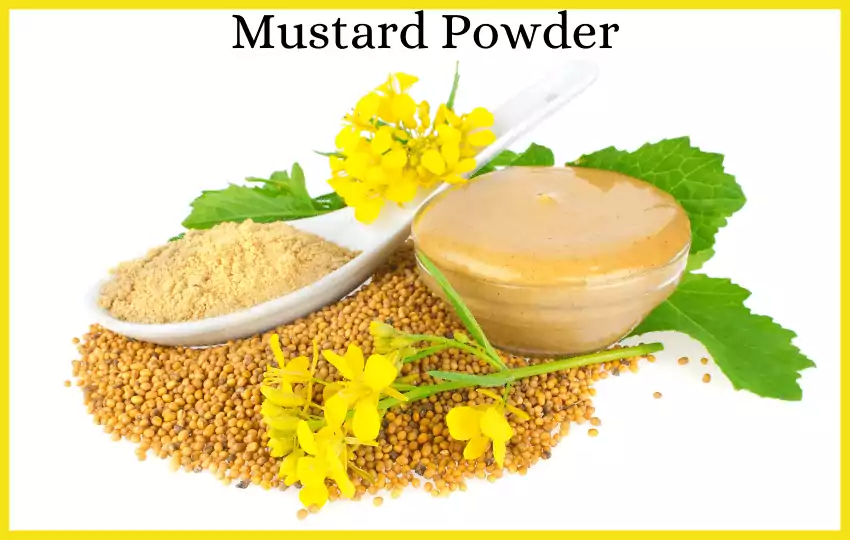Finding a mustard powder substitute is relatively easy but choosing a good substitute for mustard powder is not easy.
So I bring those alternatives for mustard powder. Depending on the food and what you have on hand, make your selection.
| Substitute Names | Amount |
| 1. Prepared Mustard | 1 Tbsp for 1 tsp |
| 2. Mustard Seeds | 1 cup for 6 tbsp |
| 3. Horseradish Powder | 1:1 |
| 4. Arugula | 1 tbsp- 1 tsp |
| 5. Dijon Mustard | 1 tbsp for 1 tsp |
| 6. Wasabi Powder | 1/2 portion |
| 7. Turmeric | 1/2 amount |
| 8. Yellow Mustard | as per your need |
What is mustard powder? What is a mustard powder made of?
Mustard powder is ground mustard seeds. It comes from the plant known as Brassica juncea or Brassica hirta that belongs to the Brassicaceae family.
Although the mustard seeds are used to powder are mostly yellow mustard powder made from stone-ground yellow mustard seed.
The seeds are ground to obtain a fine and aromatic powder used in recipes, and for dyeing, among other things.
What can You use instead of mustard powder? – 8 Mustard Powder Substitutes
Mustard has a different aromatic flavor, and it is a spicy and slightly bitter aftertaste.
1. PREPARED MUSTARD is an Excellent Substitute for mustard Powder
Prepared mustard is simply the old-fashioned condiment. It is a good alternative for mustard powder in various dishes.
Prepared Mustard mainly ground mustard with salt and vinegar to make a smooth consistency. Ues 1 tablespoon of prepared mustard for 1 teaspoon of mustard powder.
But it is not cooked like most other condiments. It is mixed with other ingredients to make ready-to-use mustards; French’s Mustard is the best example.
To use prepared mustard in the place of mustard powder, you will need to follow these steps:
1. Start by mixing the prepared mustard and vinegar in a bowl.
2. Add the sugar, salt, and pepper, and mix until well combined.
3. Gradually add the vegetable or olive oil, whisking continually until the mixture becomes thickened.
4. Use as you would regular mustard powder.
2. Mustard Powder Substitute MUSTARD SEEDS
Mustard seeds are the tiny, round seeds of the mustard plant. The seeds are usually black or yellow in color. Use 1 cup of mustard seeds for 6 spoons of mustard powder.
Mustard is a spice made from mustard plant seeds. It is often used in Indian and Asian cuisine.

The seeds can be utilised whole or processed into a powder. When used whole, the seeds add a nice crunch and bold flavor to whatever they are added to.
The powder is made by removing the seeds from their pods and grinding the seeds into a powder. The resulting powder may have a slightly brownish-yellow color to it, depending on how long it was ground for.
Although most mustards are yellow, mustard also comes in a brown variety that is often referred to as “Chinese Mustard,” which has the same color as the mustard we use in sandwich spreads.
There is also a white variety that can be used to make honey mustard.
3. Use HORSERADISH POWDER Replacement for Mustard Powder
Horseradish powder is a condiment made from the horseradish plant’s dried roots. It is a popular ingredient in many dishes, and it can also be used as a seasoning.
It has a strong flavor like mustard, so you can use it substituting mustard powder to dishes. Use a 1:1 ratio for cooking.
Horseradish is grown in most regions of the world, and the powder is used in several different cooking styles. You can enjoy a resurgence in popularity due to its unique flavor and relative ease of production.
4. ARUGULA Similar To Mustard Powder
Arugula is a lush green vegetable that is commonly used in salads. It has a peppery mustard flavor and is high in nutrients.

The arugula plant is related to mustard and can be grown in gardens. Use 1 Tablespoon Arugula paste for every teaspoon of mustard powder.
You can use Arugula in salads, sandwiches, and pasta dishes. It has a bit bitter taste that can be balanced with sweet or savory flavors. Check some other Arugula alternatives as well.
5. DIJON MUSTARD – A Decent Alternative to Mustard Powder
Dijon mustard is made with white wine and Dijon-style mustard. It is suitable for Mustard powder in sauces, salad dressing vinaigrette, and sandwiches.
Use 1 tablespoon Dijon mustard for Use 1 teaspoon dry mustard powder.
6. Use WASABI POWDER Alternative to Mustard powder for Cooking
Wasabi, a horseradish-like plant, is a popular condiment used in Japanese cuisine.
Wasabi, or Japanese horseradish, is a green plant that grows naturally in sea-level regions and thrives in wet and humid climates.
Wasabi has a similar taste to mustard, so you can easily substitute it for mustard powder in recipes. Use half portion of wasabi for every spoon of mustard powder.
However, the wasabi root is grated into a paste and used as a condiment with sushi, sashimi, and other Japanese dishes.
7. Try TURMERIC for Color like Mustard powder
Turmeric is a spice used in Indian cooking. It has a powerful flavor and can add color to food. Turmeric is also a source of antioxidants and has anti-inflammatory properties.
8. YELLOW MUSTARD Excellent Alternate for Mustard Powder
Yellow mustard is a condiment made from ground mustard seeds, vinegar, water, salt, and turmeric (which gives it its distinctive yellow color).
In the United States, it is one of the most famous condiments.
Besides being used on hot dogs, hamburgers, and other meats, yellow mustard is also used in dressings, marinades, and sauces.
Substitute for Mustard Powder in Mac and Cheese
Achieving the best creamy cheese sauce for macaroni and cheese takes patience, practice, and a little know-how. Fortunately, this guide will help you along the way.
I’ve learned to make macaroni and cheese these past few months by watching videos on YouTube, reading recipe after recipe, and of course, experimenting myself.
I’m a die-hard mustard fan, but I can’t stand that powdery stuff in the blue box. So, if you’re missing mustard powder, use equal parts Dijon and mayo for every spoon of mustard powder.
There are a few substitutes for mustard powder. You can use 1/2 teaspoon turmeric or 1/4 teaspoon cumin powder as a substitute.
You can also use 1 teaspoon dry mustard.
If you don’t use mustard much, consider placing some in the salt and pepper shakers. Know some milk substitutes for Mac & Cheese.
Mustard powder substitute for mustard seeds
If your recipe needs mustard seeds, you can use mustard powder instead. For one cup of mustard seeds, use 6 tablespoons of mustard powder.
You can use other substitutes, including horseradish, wasabi, and ginger. All three of these ingredients have some commonalities, but each one has some unique characteristics.
For example, horseradish is similar to mustard in terms of flavor, but it is much more potent.
Wasabi is spicier than mustard seeds.
Ginger is perfect for people who like spicy food but want to avoid the spiciness of mustard powder.
What do you use mustard powder for?
Mustard powder is a great spice to have on hand because it’s useful in dozens of different recipes and good for you, too. Plus, since the mustard powder is a spice, not a sauce, it’s super-versatile.
Here are six creative ways to use mustard powder:
(1) You can rub it on meats before cooking them.
(2) You can add a little to your favorite vinaigrette recipe for an extra-sharp kick.
(3) You can mix it into almost any breading mix for an instant spicy kick.
(4) Use it in salads – it actually tastes great with salads (don’t knock it ’til you try it!).
(5) Mix it in dips like mayonnaise.
(6) And, of course, you can always just slop it on your hot dog or sandwich!
Where to buy: Mustard powder is inexpensive and widely available at most grocery stores. Just pick up a small jar, and you’re good to go.
Dry mustard powder
Dry mustard powder is a spice made from the mustard plant’s ground seeds. It’s used to add flavor to food, and it comes in several different colors, including yellow, tan, and brown.
Mustard powder can be mixed with water or vinegar to make the mustard served on hot dogs and hamburgers.
You can use dry mustard powder in various condiments, such as mustard sauce and horseradish.
You can also use dry mustard powder to add flavor to your food, also used in cooking and baking, especially in recipes that require pickling or preserving.
Remember, while dry mustard can be found in several different types of shakers, it is not the same type of powder that is used to make the yellow mustard that many people are familiar with.
What does dry mustard taste like?
It has a hot, pungent flavor and is used to add heat and flavor to dishes.
How to make dry mustard
To make dry mustard powder, you will need:
- · 1/4 cup of yellow mustard seeds
- · 1/4 cup of brown mustard seeds
- · 1/4 cup of flour
- · 1 teaspoon of salt
Instructions:
1. Preheat your cookstove to 250 degrees Fahrenheit.
2. Spread the yellow and brown mustard seeds on a baking sheet and roast for about 15 minutes, stirring occasionally. They should be lightly toasted and slightly browned.
3. Remove from the oven and let cool.
4. In a blender or food processor, grind the roasted seeds into a powder.
5. Sift through the powder to remove large chunks and discard them.
6. Add the salt and flour to the powder and mix well.
7. Transfer to an airtight container, like a Mason jar or spice bottle, and store in your cupboard until you are ready to serve it.
When storing dry mustard powder, be careful because the strong flavor can seep into other spices and destroy them.
Ground Mustard Powder
Ground mustard powder is a spice made from the seeds of the mustard plant. It is often used in Indian, Middle Eastern, and European cuisine.
It is an essential ingredient in many types of hot, spicy curry powders and is used as a condiment. It is also popularly referred to as “yellow powder” in some parts of the world.
Ground mustard can be used in many recipes, either alone or mixed with other spices, to make various types of hot and spicy curry powders.
It can also be used as a seasoning in cold dishes such as salads, sandwiches, and hors d’oeuvres. It is also used in pickling.
When mixed with vinegar, mustard becomes a versatile condiment that can be served with meats such as ham and sausages.
It can also be used with mayonnaise to produce a sandwich spread or with sour cream to make a dip. Flavored mayonnaises, vinaigrettes, marinades, and glazes can also be made using it.
Is mustard flour the same as a mustard powder?
No, they are two different products.
Mustard flour is made by finely grinding mustard seeds into a powder. It’s then mixed with water and vinegar to form a paste.
Mustard powder is made by crushing mustard seeds into a seed-sized crumble then mixing them with water, vinegar, and other spices. The mixture is then dried in large ovens to create a fluffy powder.
Both types are common in European and North American cuisine. Mustard flour is frequently used in French cooking, while mustard powder is featured more frequently in British recipes.
FAQs Related to Mustard Powder & Its Alternatives
Q1. Can you use regular mustard instead of mustard powder?
Yes, you can use regular mustard instead of mustard powder. Mustard powder is just a finer form of ground-up yellow mustard seeds.
If you have entire yellow seeds, simply pound them in a mortar and pestle (or food processor) until finely ground.
Want a sharper or spicier flavor? Increase the amount for both ingredients to 1/2 teaspoon.
If it’s too hot, decrease one to 3/4 teaspoon of ground mustard and reduce the added sugar by 1-2 tablespoons.
Q2. 1 tablespoon of dry mustard equals how much prepared mustard?
1 tablespoon of dry mustard equals 3 teaspoons of prepared mustard.
Q3. Is ground mustard the same as a mustard powder?
It is not. Ground mustard is not made from mustard powder, though the two are related.
Ground mustard vs Mustard powder
Ground mustard is made from the seeds of the mustard plant that have first been soaked in water.
Once it has absorbed enough water, the ground mustard is mixed with vinegar and spices to create a condiment similar in strength and flavor to prepared mustard.
On the other hand, the mustard powder is made from ground mustard seeds, and then vinegar and spices are added to it.
The taste of the two is quite different, though they can be used interchangeably.
Ground mustard has a more potent flavor than prepared mustard. Still, it is possible to make ground mustard with less pungency by using milder seeds.
Ground mustard is much easier to make since it doesn’t require any soaking or boiling. It can be smoothly made at home for personal use, as it doesn’t require any special equipment.
But mustard powder has a much longer shelf life.
Q4. Can you use mustard instead of mustard powder?
Yes, you can use mustard instead of mustard powder. No, we’re not kidding. This is true if you use a little bit of whole grain mustard (such as Maille ), which by itself is not very intense in terms of taste.
Of course, it depends on the dish you are preparing, its ingredients, and other condiments. Still, the substitution is possible in most cases.
The taste will not be exactly the same as using mustard powder. However, it will definitely still be a viable option for your cooking.
Q5. Is Colman’s mustard powder gluten-free?
The answer is no. Colman’s mustard powder is not gluten-free. The company states that it does contain wheat, rye, and barley in the product.
Q6. What is the difference between a mustard seed and mustard powder?
Mustard seeds are the larger, stratified fruit of a mustard plant. They start out yellowish in color and turn to brown after being dried, whereas mustard powder starts out brown in color.
Both are used in making mustard, but when ground or shaken together with water, they form two different textures.
Mustard seed is the main ingredient for spreading it directly onto food, while mustard powder is either used alone or added as an ingredient to another dish that’s being prepared.

